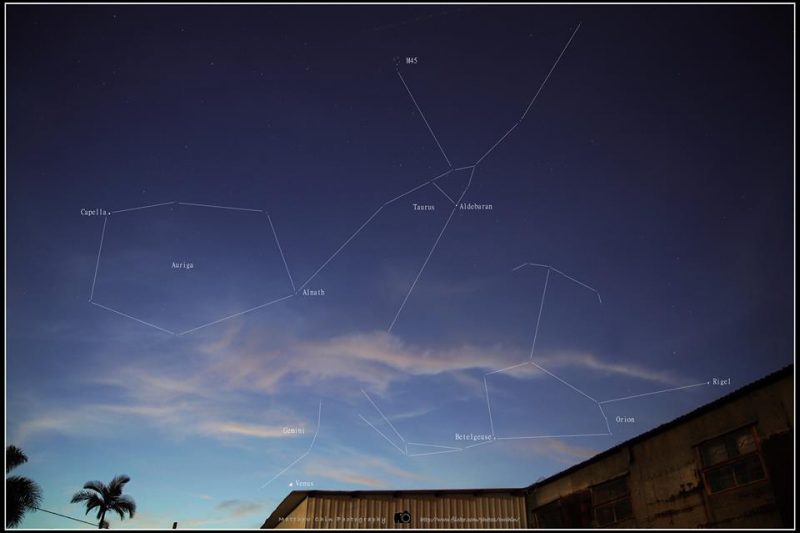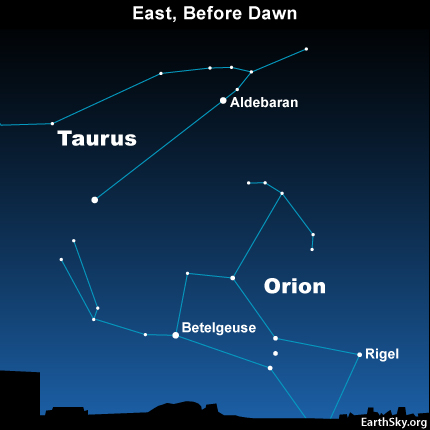
Orion the Hunter returns
Every year, in late July and early August, look eastward as darkness gives way to morning dawn. In a clear sky, you can glimpse the beautiful constellation Orion the Hunter. It’s one of the sky’s most easily seen constellations. Orion always passes behind the sun in Northern Hemisphere spring. By June, Orion is gone from our sky. But then, at this time of year, Orion returns, ascending once more in the east before sunrise. The Hunter rises on his side, with his three Belt stars – Mintaka, Alnitak and Alnilam – pointing upward. It’s a stirring sight, and one you can look forward to for all the years of your life.
It’s why Orion has been called the ghost of the shimmering summer dawn.
As seen from the Northern Hemipshere, Orion appears in winter as a mighty constellation arcing across the south during the evening hours. Many people see Orion then and notice this distinctive, large and bright pattern of stars. From the Southern Hemisphere, Orion arcs high across the sky – closer to overhead – around December and January. And, at this time of year (late July and early August), Orion is up in the east before sunrise on Southern Hemisphere winter mornings.
Want a view of Orion from your location? Try Stellarium
It’s meteor season. Everything you need to know: Perseid meteor shower


How can you be sure it’s Orion?
If you’re new to stargazing, the night sky with its plethora of stars can be bewildering. The good news is that the stars stay “fixed” relative to each other. If you’re not sure the pattern you’re seeing is Orion, watch for the star Aldebaran in the constellation Taurus the Bull. In a dark sky, you can see a V-shaped pattern of stars around Aldebaran. This pattern represents the Bull’s Face. Aldebaran to represent the Bull’s fiery Eye.
In skylore, Orion is said to be holding up a great shield … fending off the charging Bull. It’s easy to imagine when you look eastward before sunup at this time of year, or anytime you spot Orion.
Orion will soon be up by midnight, then 10 p.m. … and by December you’ll find it rising in early evening. And there’s nothing unusual about Orion’s shift from the predawn to the evening sky. This constellation is simply following the westward shift of all the stars, caused by Earth’s orbit around the sun. As we orbit the sun, our night sky points toward an ever-changing panorama of the Milky Way galaxy. Our orbit causes all the stars to rise approximately 4 minutes earlier each day.


Ghost of the shimmering summer dawn
A poem by Sophia C. Prentice, published in the magazine Popular Astronomy in April 2024, memorialized Orion’s early morning return.
Across the winter sky by night
Orion proudly strides;
The rising moon in silver state
His splendor scarcely hides;
His jeweled belt, his glittering sword,
In brilliancy combine,
Great Sirius and Procyon,
His loyal followers shine,
The Book of books records his name,
Of him the poets write;
From nursery windows, children’s eyes
Greet him with gay delight.The soft breeze stirs to greet the dawn,
The summer stars grow dim,
When lo, a mystic shape appears
Above the Ocean’s rim.
The form so faintly shining there
No royalty can boast,
Yet with a thrill my heart proclaims,
‘It is Orion’s ghost!”Alone and pale he trembles there
A moment and is gone,
While radiant couriers of the sun
Announce the coming morn.Orion, greatest of the tribe
That pace the starry heights.
Ghost of the shimmering summer dawn,
King of the winter nights!
Bottom line: The return of Orion and Taurus to your predawn sky happens around late July or early August every year. In the Northern Hemisphere, Orion is sometimes called the ghost of the shimmering summer dawn. That name comes from a 1924 poem by Sophia C.Prentice.
Enjoying EarthSky so far? Sign up for our free daily newsletter today!
The post Orion the Hunter returns late July or early August first appeared on EarthSky.
from EarthSky https://ift.tt/3BUjTQn

Orion the Hunter returns
Every year, in late July and early August, look eastward as darkness gives way to morning dawn. In a clear sky, you can glimpse the beautiful constellation Orion the Hunter. It’s one of the sky’s most easily seen constellations. Orion always passes behind the sun in Northern Hemisphere spring. By June, Orion is gone from our sky. But then, at this time of year, Orion returns, ascending once more in the east before sunrise. The Hunter rises on his side, with his three Belt stars – Mintaka, Alnitak and Alnilam – pointing upward. It’s a stirring sight, and one you can look forward to for all the years of your life.
It’s why Orion has been called the ghost of the shimmering summer dawn.
As seen from the Northern Hemipshere, Orion appears in winter as a mighty constellation arcing across the south during the evening hours. Many people see Orion then and notice this distinctive, large and bright pattern of stars. From the Southern Hemisphere, Orion arcs high across the sky – closer to overhead – around December and January. And, at this time of year (late July and early August), Orion is up in the east before sunrise on Southern Hemisphere winter mornings.
Want a view of Orion from your location? Try Stellarium
It’s meteor season. Everything you need to know: Perseid meteor shower


How can you be sure it’s Orion?
If you’re new to stargazing, the night sky with its plethora of stars can be bewildering. The good news is that the stars stay “fixed” relative to each other. If you’re not sure the pattern you’re seeing is Orion, watch for the star Aldebaran in the constellation Taurus the Bull. In a dark sky, you can see a V-shaped pattern of stars around Aldebaran. This pattern represents the Bull’s Face. Aldebaran to represent the Bull’s fiery Eye.
In skylore, Orion is said to be holding up a great shield … fending off the charging Bull. It’s easy to imagine when you look eastward before sunup at this time of year, or anytime you spot Orion.
Orion will soon be up by midnight, then 10 p.m. … and by December you’ll find it rising in early evening. And there’s nothing unusual about Orion’s shift from the predawn to the evening sky. This constellation is simply following the westward shift of all the stars, caused by Earth’s orbit around the sun. As we orbit the sun, our night sky points toward an ever-changing panorama of the Milky Way galaxy. Our orbit causes all the stars to rise approximately 4 minutes earlier each day.


Ghost of the shimmering summer dawn
A poem by Sophia C. Prentice, published in the magazine Popular Astronomy in April 2024, memorialized Orion’s early morning return.
Across the winter sky by night
Orion proudly strides;
The rising moon in silver state
His splendor scarcely hides;
His jeweled belt, his glittering sword,
In brilliancy combine,
Great Sirius and Procyon,
His loyal followers shine,
The Book of books records his name,
Of him the poets write;
From nursery windows, children’s eyes
Greet him with gay delight.The soft breeze stirs to greet the dawn,
The summer stars grow dim,
When lo, a mystic shape appears
Above the Ocean’s rim.
The form so faintly shining there
No royalty can boast,
Yet with a thrill my heart proclaims,
‘It is Orion’s ghost!”Alone and pale he trembles there
A moment and is gone,
While radiant couriers of the sun
Announce the coming morn.Orion, greatest of the tribe
That pace the starry heights.
Ghost of the shimmering summer dawn,
King of the winter nights!
Bottom line: The return of Orion and Taurus to your predawn sky happens around late July or early August every year. In the Northern Hemisphere, Orion is sometimes called the ghost of the shimmering summer dawn. That name comes from a 1924 poem by Sophia C.Prentice.
Enjoying EarthSky so far? Sign up for our free daily newsletter today!
The post Orion the Hunter returns late July or early August first appeared on EarthSky.
from EarthSky https://ift.tt/3BUjTQn

Aucun commentaire:
Enregistrer un commentaire